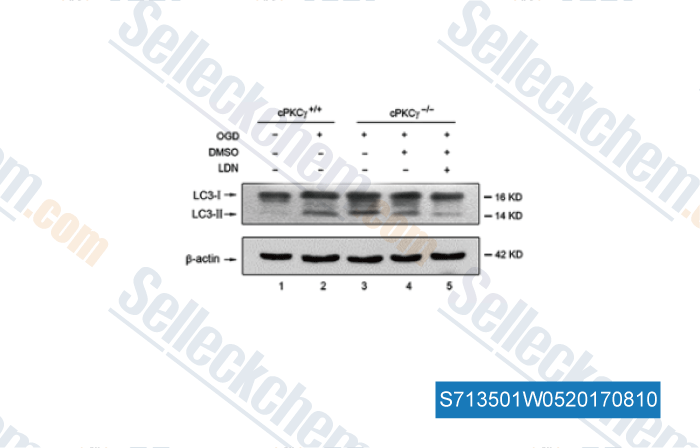|
How to Cite 1. For In-Text Citation (Materials & Methods): 2. For Key Resources Table: |
||
|
Toll Free: (877) 796-6397 -- USA and Canada only -- |
Fax: +1-832-582-8590 Orders: +1-832-582-8158 |
Tech Support: +1-832-582-8158 Ext:3 Please provide your Order Number in the email. We strive to reply to |
Technical Data
| Formula | C17H11Cl3N2O3 |
||||||||||||||
| Molecular Weight | 397.64 | CAS No. | 668467-91-2 | ||||||||||||
| Solubility (25°C)* | In vitro | DMSO | 11 mg/mL (27.66 mM) | ||||||||||||
| Water | Insoluble | ||||||||||||||
| Ethanol | Insoluble | ||||||||||||||
| In vivo (Add solvents to the product individually and in order) |
|
||||||||||||||
|
* <1 mg/ml means slightly soluble or insoluble. * Please note that Selleck tests the solubility of all compounds in-house, and the actual solubility may differ slightly from published values. This is normal and is due to slight batch-to-batch variations. * Room temperature shipping (Stability testing shows this product can be shipped without any cooling measures.) |
|||||||||||||||
Preparing Stock Solutions
Biological Activity
| Description | LDN-57444 is a reversible, competitive proteasome inhibitor for Uch-L1 with IC50 of 0.88 μM, 28-fold selectivity over isoform Uch-L3. | ||||||
|---|---|---|---|---|---|---|---|
| Targets |
|
||||||
| In vitro | Treatment with 50 μM LDN-57444 for 24 h leads to 70% inhibition of the proteasome activity. This compound causes a significant and concentration-dependent decrease in cell viability at concentrations above 25 μM and the cell viability reduced to 61.81% at 50 μM. It is able to cause cell death through the apoptosis pathway by decreasing the activity of ubiquitin proteasome system and increasing the levels of highly ubiquitinated proteins, both of which can activate unfolded protein response. The apoptosis induced by this chemical may be triggered by the activation of endoplasmic reticulum stress (ERS). [4] | ||||||
| In vivo | LDN-57444 causes dramatic alterations in synaptic protein distribution and spine morphology in vivo. Treatment with this compound also results in a rapid fall of Uch-L1 activity, but proteasome inhibition has no effect on cAMP levels over a period of several hours. [3] |
Protocol (from reference)
| Kinase Assay:[1] |
|
|---|---|
| Cell Assay:[1] |
|
References
|
Customer Product Validation

-
Data from [ , , J Cell Mol Med, 2017, 1-16 ]
Selleck's LDN-57444 Has Been Cited by 15 Publications
| Ubiquitin C-terminal hydrolase L1 promoted pro-angiogenic capacity of periodontal ligament stem cells via HIF-1α/YAP signaling in periodontitis [ Stem Cell Res Ther, 2025, 16(1):271] | PubMed: 40457476 |
| Deficiency of UCHL1 results in insufficient decidualization accompanied by impaired dNK modulation and eventually miscarriage [ J Transl Med, 2024, 22(1):478] | PubMed: 38769534 |
| The Suppression of Ubiquitin C-Terminal Hydrolase L1 Promotes the Transdifferentiation of Auditory Supporting Cells into Hair Cells by Regulating the mTOR Pathway [ Cells, 2024, 13(9)737] | PubMed: 38727276 |
| Stem Cell Properties of Gastric Cancer Stem-Like Cells under Stress Conditions Are Regulated via the c-Fos/UCH-L3/β-Catenin Axis [ Mol Cells, 2023, 46(8):476-485] | PubMed: 37460253 |
| Stem Cell Properties of Gastric Cancer Stem-Like Cells under Stress Conditions Are Regulated via the c-Fos/UCH-L3/β-Catenin Axis [ Mol Cells, 2023, 46(8):476-485] | PubMed: 37460253 |
| UCHL1 regulates inflammation via MAPK and NF-κB pathways in LPS-activated macrophages [ Cell Biol Int, 2021, 10.1002/cbin.11662] | PubMed: 34288216 |
| Long-term inhibition of UCHL1 decreases hypertension and retinopathy in spontaneously hypertensive rats [ J Int Med Res, 2021, 49(6):3000605211020641] | PubMed: 34130526 |
| The Deubiquitinating Enzyme UCHL1 Promotes Resistance to Pemetrexed in Non-Small Cell Lung Cancer by Upregulating Thymidylate Synthase [ Theranostics, 2020, 15;10(13):6048-6060] | PubMed: 32483437 |
| Deubiquitination of CD36 by UCHL1 promotes foam cell formation [ Cell Death Dis, 2020, 11(8):636] | PubMed: 32801299 |
| Blockage of UCHL1 Activity Attenuates Cardiac Remodeling in Spontaneously Hypertensive Rats [ Hypertens Res, 2020, 10.1038/s41440-020-0486-1] | PubMed: 32541849 |
RETURN POLICY
Selleck Chemical’s Unconditional Return Policy ensures a smooth online shopping experience for our customers. If you are in any way unsatisfied with your purchase, you may return any item(s) within 7 days of receiving it. In the event of product quality issues, either protocol related or product related problems, you may return any item(s) within 365 days from the original purchase date. Please follow the instructions below when returning products.
SHIPPING AND STORAGE
Selleck products are transported at room temperature. If you receive the product at room temperature, please rest assured, the Selleck Quality Inspection Department has conducted experiments to verify that the normal temperature placement of one month will not affect the biological activity of powder products. After collecting, please store the product according to the requirements described in the datasheet. Most Selleck products are stable under the recommended conditions.
NOT FOR HUMAN, VETERINARY DIAGNOSTIC OR THERAPEUTIC USE.
